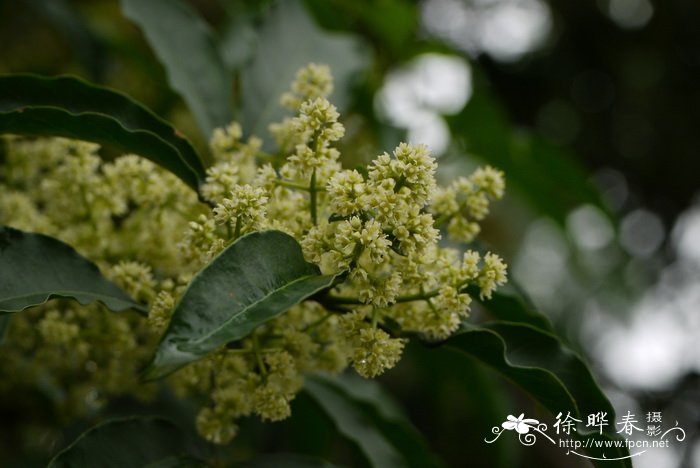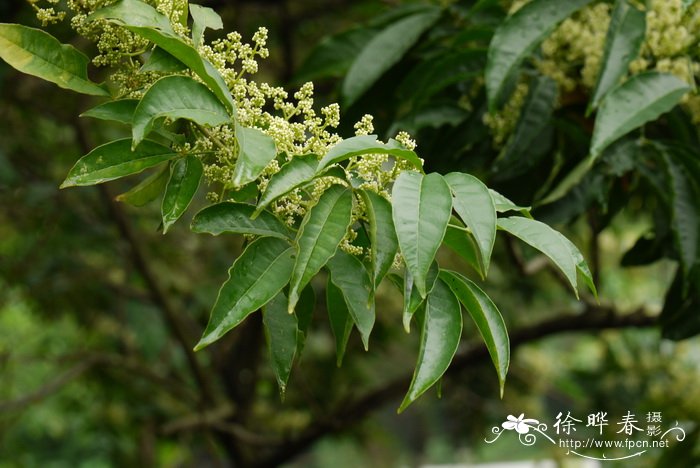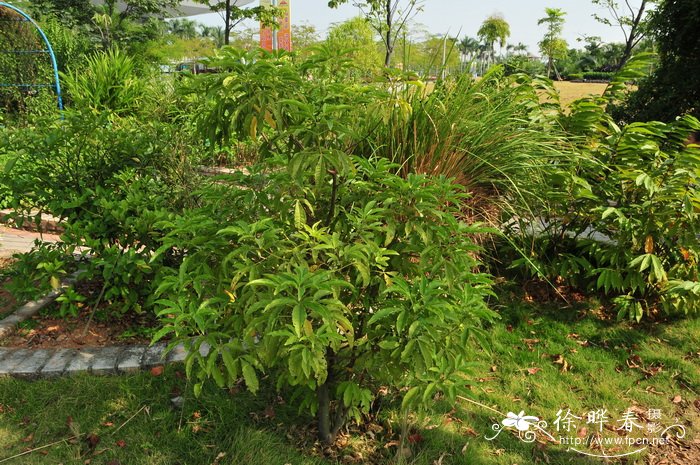三桠苦Melicope pteleifolia
中文名(Chinese Name):三桠苦
学名(Scientific Name):Melicope pteleifolia (Champ. ex Benth.) Hartley
英文名(English Common Name):
别名(Chinese Common Name):三脚鳖、白芸香
异名(Synonym):Evodia lepta (Spreng.) Merr. Evodia lepta var. cambodiana (Pierre)Huang Evodia lamarckiana Benth. Evodia chunii Merr. Evodia pteleaefolia (Champ. ex Benth.) Merr. Evodia lepta var. chunii (Merr.) C. C. Huang Evodia triphylla var. cambodiana Pierre Lepta triphylla Lour. Evodia roxbourghiana Benth. Zanthoxylum pteleaefolium Champion ex Bentham Evodia pteleifolia (Spreng.) Merr. Ilex lepta Spreng. Euodia gracilis Kurz Euodia lepta var. cambodiana (Pierre) C.C. Huang Euodia lepta (Spreng.) Merr. Euodia oreophila Guillaumin Euodia pteleifolia (Champ. ex Benth.) Merr. Euodia triphylla var. cambodiana Pierre Zanthoxylum pteleifolium Champ. ex Benth.
科属(Family & Genus):芸香科(Rutaceae)吴茱萸属
形态特征(Description):乔木,树皮灰白或灰绿色,光滑,纵向浅裂,嫩枝的节部常呈压扁状,小枝的髓部大,枝叶无毛。3小叶,有时偶有2小叶或单小叶同时存在,叶柄基部稍增粗,小叶长椭圆形,两端尖,有时倒卵状椭圆形,长6-20厘米,宽2-8厘米,全缘,油点多;小叶柄甚短。花序腋生,很少同时有顶生,长4-12厘米,花甚多;萼片及花瓣均4片;萼片细小,长约0.5毫米;花瓣淡黄或白色,长1.5-2毫米,常有透明油点,干后油点变暗褐至褐黑色;雄花的退化雌蕊细垫状凸起,密被白色短毛;雌花的不育雄蕊有花药而无花粉,花柱与子房等长或略短,柱头头状。分果瓣淡黄或茶褐色,散生肉眼可见的透明油点,每分果瓣有1种子;种子长3-4毫米,厚2-3毫米,蓝黑色,有光泽。花期4-6月,果期7-10月。
分布(Distribution):产台湾、福建、江西、广东、海南、广西、贵州及云南,生于平地至海拔2000米山地,常见于较阴蔽的山谷湿润地方。越南、老挝、泰国等也有。
用途(Use):根、叶、果都用作草药。味苦。性寒,一说其根有小毒。在我国及越南、老挝、柬埔寨均用作清热解毒剂。广东“凉茶”中,多有此料,用其根、茎枝,作消暑清热剂。
引自中国植物志英文版: FOC Vol. 11 Page 70, 72
Melicope pteleifolia (Champion ex Bentham) T. G. Hartley, Fl. Taiwan, ed. 2. 3: 521. 1993.
三桠苦 san ya ku| Rutaceae | Melicope
Zanthoxylum pteleifolium Champion ex Bentham, Hooker’s J. Bot. Kew Gard. Misc. 3: 350. 1851; Euodia gracilis Kurz; E. lepta Merrill, nom. illeg. superfl.; E. lepta var. cambodiana (Pierre) C. C. Huang; E. oreophila Guillaumin (1945), not Guillaumin (1938); E. pteleifolia (Champion ex Bentham) Merrill; E. triphylla (Lamarck) Candolle var. cambodiana Pierre; Ilex lepta Sprengel, nom. illeg. superfl.; Lepta triphylla Loureiro.
Shrubs or trees, rarely scandent, 1-14 m tall, dioecious or rarely monoclinous. Young branchlets 2.5-4 mm wide in third internode. Leaves 3-foliolate (occasional leaves 1-foliolate); petiole 1.5-14 cm, glabrous to pubescent; leaflet blades ovate-elliptic, elliptic, elliptic-obovate, or narrowly so, in terminal leaflet 6-22 × 2-8 cm, glabrous or puberulent on midvein especially abaxially, apex acuminate or subcaudate. Inflorescences axillary and sometimes basal to leaves, 2-10 × 1.5-8 cm; peduncle 0.4-5 cm; larger primary branches usually spreading. Pedicel 0.6-3 mm but 1.5-6 mm in fruit, sparsely puberulent to pubescent. Sepals 0.5-1(-1.5) mm, connate at base or to ca. 1/4 their length, glabrous or outside pubescent, persistent in fruit. Petals 1.3-2(-2.5) mm, deciduous or rarely persistent in fruit. Stamens 4, in male and bisexual flowers 1.5-3(-4) mm, in female flowers 0.4-1.5 mm; filaments at least in male and bisexual flowers subulate to filiform at apex. Gynoecium in female and bisexual flowers 1-2 mm, in male flowers 0.2-0.5 mm; ovary glabrous to pubescent. Fruit follicles subglobose to ellipsoid to obovoid, (3-)3.5-7.5 mm, glabrous or sparsely puberulent. Seeds subglobose to ovoid to ellipsoid, 2.5-4 mm, attachment Type B. Fl. Apr-Jun, fr. Jul-Oct.
Evergreen and mixed deciduous forests and forest margins, thickets, swamp forests, open places; near sea level to 2300(-2800) m. Fujian, Guangdong, SW Guangxi, Hainan, S Jiangxi, Taiwan, Yunnan, SE Zhejiang [Cambodia, Laos, Myanmar, Thailand, Vietnam].



(责任编辑:徐晔春)
学名(Scientific Name):Melicope pteleifolia (Champ. ex Benth.) Hartley
英文名(English Common Name):
别名(Chinese Common Name):三脚鳖、白芸香
异名(Synonym):Evodia lepta (Spreng.) Merr. Evodia lepta var. cambodiana (Pierre)Huang Evodia lamarckiana Benth. Evodia chunii Merr. Evodia pteleaefolia (Champ. ex Benth.) Merr. Evodia lepta var. chunii (Merr.) C. C. Huang Evodia triphylla var. cambodiana Pierre Lepta triphylla Lour. Evodia roxbourghiana Benth. Zanthoxylum pteleaefolium Champion ex Bentham Evodia pteleifolia (Spreng.) Merr. Ilex lepta Spreng. Euodia gracilis Kurz Euodia lepta var. cambodiana (Pierre) C.C. Huang Euodia lepta (Spreng.) Merr. Euodia oreophila Guillaumin Euodia pteleifolia (Champ. ex Benth.) Merr. Euodia triphylla var. cambodiana Pierre Zanthoxylum pteleifolium Champ. ex Benth.
科属(Family & Genus):芸香科(Rutaceae)吴茱萸属
形态特征(Description):乔木,树皮灰白或灰绿色,光滑,纵向浅裂,嫩枝的节部常呈压扁状,小枝的髓部大,枝叶无毛。3小叶,有时偶有2小叶或单小叶同时存在,叶柄基部稍增粗,小叶长椭圆形,两端尖,有时倒卵状椭圆形,长6-20厘米,宽2-8厘米,全缘,油点多;小叶柄甚短。花序腋生,很少同时有顶生,长4-12厘米,花甚多;萼片及花瓣均4片;萼片细小,长约0.5毫米;花瓣淡黄或白色,长1.5-2毫米,常有透明油点,干后油点变暗褐至褐黑色;雄花的退化雌蕊细垫状凸起,密被白色短毛;雌花的不育雄蕊有花药而无花粉,花柱与子房等长或略短,柱头头状。分果瓣淡黄或茶褐色,散生肉眼可见的透明油点,每分果瓣有1种子;种子长3-4毫米,厚2-3毫米,蓝黑色,有光泽。花期4-6月,果期7-10月。
分布(Distribution):产台湾、福建、江西、广东、海南、广西、贵州及云南,生于平地至海拔2000米山地,常见于较阴蔽的山谷湿润地方。越南、老挝、泰国等也有。
用途(Use):根、叶、果都用作草药。味苦。性寒,一说其根有小毒。在我国及越南、老挝、柬埔寨均用作清热解毒剂。广东“凉茶”中,多有此料,用其根、茎枝,作消暑清热剂。
引自中国植物志英文版: FOC Vol. 11 Page 70, 72
Melicope pteleifolia (Champion ex Bentham) T. G. Hartley, Fl. Taiwan, ed. 2. 3: 521. 1993.
三桠苦 san ya ku| Rutaceae | Melicope
Zanthoxylum pteleifolium Champion ex Bentham, Hooker’s J. Bot. Kew Gard. Misc. 3: 350. 1851; Euodia gracilis Kurz; E. lepta Merrill, nom. illeg. superfl.; E. lepta var. cambodiana (Pierre) C. C. Huang; E. oreophila Guillaumin (1945), not Guillaumin (1938); E. pteleifolia (Champion ex Bentham) Merrill; E. triphylla (Lamarck) Candolle var. cambodiana Pierre; Ilex lepta Sprengel, nom. illeg. superfl.; Lepta triphylla Loureiro.
Shrubs or trees, rarely scandent, 1-14 m tall, dioecious or rarely monoclinous. Young branchlets 2.5-4 mm wide in third internode. Leaves 3-foliolate (occasional leaves 1-foliolate); petiole 1.5-14 cm, glabrous to pubescent; leaflet blades ovate-elliptic, elliptic, elliptic-obovate, or narrowly so, in terminal leaflet 6-22 × 2-8 cm, glabrous or puberulent on midvein especially abaxially, apex acuminate or subcaudate. Inflorescences axillary and sometimes basal to leaves, 2-10 × 1.5-8 cm; peduncle 0.4-5 cm; larger primary branches usually spreading. Pedicel 0.6-3 mm but 1.5-6 mm in fruit, sparsely puberulent to pubescent. Sepals 0.5-1(-1.5) mm, connate at base or to ca. 1/4 their length, glabrous or outside pubescent, persistent in fruit. Petals 1.3-2(-2.5) mm, deciduous or rarely persistent in fruit. Stamens 4, in male and bisexual flowers 1.5-3(-4) mm, in female flowers 0.4-1.5 mm; filaments at least in male and bisexual flowers subulate to filiform at apex. Gynoecium in female and bisexual flowers 1-2 mm, in male flowers 0.2-0.5 mm; ovary glabrous to pubescent. Fruit follicles subglobose to ellipsoid to obovoid, (3-)3.5-7.5 mm, glabrous or sparsely puberulent. Seeds subglobose to ovoid to ellipsoid, 2.5-4 mm, attachment Type B. Fl. Apr-Jun, fr. Jul-Oct.
Evergreen and mixed deciduous forests and forest margins, thickets, swamp forests, open places; near sea level to 2300(-2800) m. Fujian, Guangdong, SW Guangxi, Hainan, S Jiangxi, Taiwan, Yunnan, SE Zhejiang [Cambodia, Laos, Myanmar, Thailand, Vietnam].
(责任编辑:徐晔春)
踩一下[0]

顶一下[1]